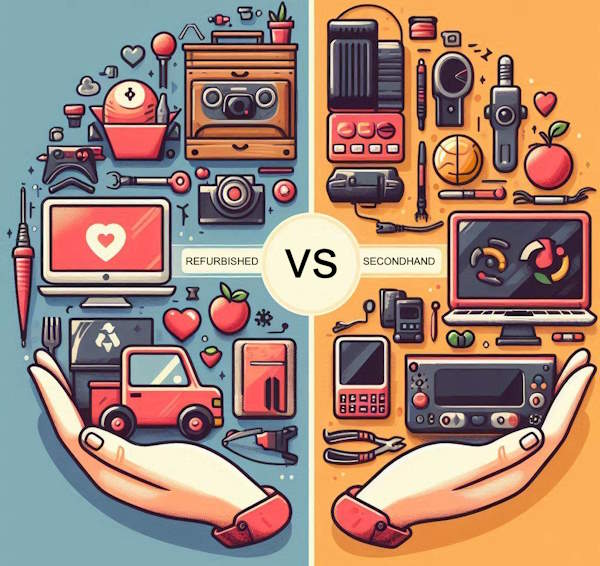In this article, we’ll set aside our usual topics of HTML editing and web development to discuss a crucial environmental issue that can help preserve the Earth: the importance of buying refurbished ♻️ hardware.
Purchasing refurbished hardware is often aimed at saving money on technology. For this reason, you can find such hardware on various devices and even servers. The refurbished market is large and valued at $9 billion in the US. This means that you can very well rent a dedicated server in the USA assembled from brand-new or refurbished hardware, and save some money. Does it mean that when you opt for “refurbished” you compromise on the quality? Not universally, no.

Some people associate refurbished hardware with lower quality. But it’s not the case in many instances. To be fair, it is often hard to distinguish what “refurbished” means. In this article, we will explore what the term “refurbished” implies, what are the pros and cons of refurbished hardware, and what you should pay attention to when deciding to opt for this type of hardware.
What does “refurbished” mean?
The term “refurbished” is falsely associated with the descriptive terms “low-quality”, “unreliable”, and “short-lived” 📉. And it’s all because of the assumption that used and refurbished hardware are the same thing; but, they’re not. Used and refurbished hardware have fundamental differences.
“Used” means that devices and hardware in general have already been owned by somebody, and their previous owner has renounced them. It also means that the hardware has undergone no repairs of any kind; so, in whatever condition it left its previous user, in the same condition, it will go to a new one. It is true that sometimes, items classified as used have never actually been in use.

The fundamental difference between the terms “used” and “refurbished” is that refurbished hardware has undergone professional repairs before attempting to find another owner. Those repairs often focus on eliminating manufacturer defects or operational difficulties that aren’t caused by improper use.
Refurbished hardware comes with a warranty 🛡️, and in most cases is repaired by the manufacturer itself. It may also have certifications like NAID AAA Certification, R2v3 Certification, e-Stewards 4.1 Certification, and guarantees of functionality. Nonetheless, refurbished items can offer a much lower price compared to brand-new hardware.
Since a piece of hardware cannot be called refurbished without having any guarantee of functionality, the risk of buying hardware that doesn’t work anymore is reduced to a minimum. Also, devices and components that have long been discontinued are less likely to be listed for sale as refurbished.
Pros and cons of refurbished hardware
Pros
- 💲 The main advantage of refurbished technology is its price. People can save a lot of money by buying refurbished hardware. It also makes items more accessible to a wider range of consumers.
- 🔎 Tested hardware. Refurbished hardware undergoes extensive testing, often more than new hardware, as it needs to ensure the original issues have been resolved. So, when you opt for refurbished hardware, you are actually getting a fully tested device.
- 🌱 Helping the environment. By using refurbished hardware and making use of what is already produced, you reduce the manufacturing capacity needed to create new products to satisfy the demand.
Cons
- 🛠️ Unclear reasons for repair. You may not always know the exact reasons why the hardware was refurbished.
- 🔙 A risk of not being able to return items. If you choose an untrustworthy seller there is a risk of not being able to return it since you won’t get a proper warranty.
- 🛒 Fluctuating availability. The availability of refurbished hardware depends on the market and you may not be able to find the exact product you need.
- ⌛ Shorter life cycle. While the assumption that the refurbished hardware doesn’t live quite as long as the new one is slightly exaggerated, it is also fair — the lifespan of refurbished hardware is shorter than one of the newly manufactured.
What is worth paying attention to before buying refurbished products
If you decide to buy refurbished products, here are the main aspects we recommend you take into account.
- Purchase from a manufacturer. The best way to buy refurbished hardware is from an official manufacturer. This way you get a reliable guarantee that the product will be operational. You get a product that has been tested and repaired by experts who created it.
- Get hardware from approved refurbishers. If you, for whatever reason, don’t want to buy from a manufacturer, can look for certified technicians that specialize in refurbishment. Research the seller and look for certifications or other proof of expertise before buying hardware from them.
- Ensure hardware comes with a warranty. Regardless of where you buy the hardware from, it should have a warranty. Refurbished products without a warranty should be avoided.
In some cases, refurbished hardware might be a better choice than new hardware. If you’re on a budget but are looking for quality products, refurbished hardware can be what satisfies your needs best. While it doesn’t mean that all refurbished products are intrinsically high-quality, some of them might offer you a good deal.